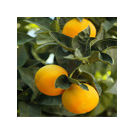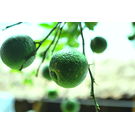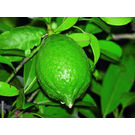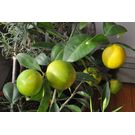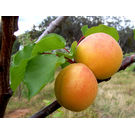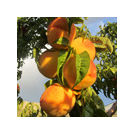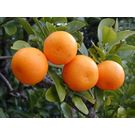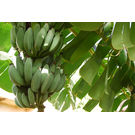Kaji ( Kagoji) Lemon Plant

Description
Lemon, Citrus limon, is a small evergreen tree in the family Rutaceae grown for its edible fruit which, among other things, are used in a variety of foods and drinks. The tree has a spreading, upright growth habit, few large branches and stiff thorns. The tree possesses large, oblong or oval, light green leaves and produces purple-white flowers in clusters. The lemon fruit is an ellipsoid berry surrounded by a green rind, which ripens to yellow, protecting soft yellow segmented pulp. Lemon trees can reach 3–6 m (10–20 ft) in height and can live for many years, reaching full fruit bearing capacity in approximately 40 years. Lemon may also be referred to as bush lemon or Persian apple and likely originated from the eastern Himalaya of India.
The true lemon tree reaches 10 to 20 ft (3-6 m) in height and usually has sharp thorns on the twigs. The alternate leaves, reddish when young, become dark-green above, light-green below; are oblong, elliptic or long-ovate, 2 1/2 to 4 1/2 in (6.25-11.25 cm) long, finely toothed, with slender wings on the petioles. The mildly fragrant flowers may be solitary or there may be 2 or more clustered in the leaf axils. Buds are reddish; the opened flowers have 4 or 5 petals 3/4 in (2 cm) long, white on the upper surface (inside), purplish beneath (outside), and 20-40 more or less united stamens with yellow anthers. The fruit is oval with a nipple-like protuberance at the apex; 2 3/4 to 4 3/4 in (7 -12 cm) long; the peel is usually light-yellow though some lemons are variegated with longitudinal stripes of green and yellow or white; it is aromatic, dotted with oil glands; 1/4 to 3/8 in (6-10 mm) thick; pulp is pale-yellow, in 8 to 10 segments, juicy, acid. Some fruits are seedless, most have a few seeds, elliptic or ovate, pointed, smooth, 3/8 in (9.5 mm) long, white inside.
Soil
The lemon tree has the reputation of tolerating very infertile, very poor soil. In Florida, groves are mostly on sand. In California, excellent growth is maintained on silty clay loam of high water-holding capacity. In Guatemala, recommended soils are sand, clay and sandy-clay-deep, with high permeability and good drainage. Black soils are also suitable if not lying over calcareous subsoil. Ph should be between 5.5 and 6.5. If acidity is high, it is necessary to apply lime to achieve the optimum level.
Harvesting and Handling
The marketability of lemons depends on the stage at which they are picked. Italian lemons for export are harvested as early as possible and are naturally "cured" in transit. In early days, California and Florida lemons were allowed to remain on the trees until they became too large. It was realized that early picking is necessary and California and Arizona adopted the practices of picking at any time after the fruits reach a 25 % juice content, and using rings to gauge the commercially acceptable size, and repeated spot-picking with clippers. Mechanical picking is impossible with lemons. The fruits are highly prone to oil spotting (oleocellosis) and cannot be handled roughly nor picked wet.


